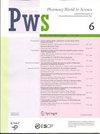ON THE PHASING OF THE CLINICAL COURSE OF PERSISTENT SUBDURAL HYDROMAS AND ON THE SELECTIVE-BY-PHASE APPROACH TO THE CHOICE OF SURGICAL INTERVENTION
引用次数: 1
Abstract
The work is based on the analysis of the surgical treatment of 181 injured persons with traumatic subdural hydromas. The clynic and pathogenic peculiarities, as well as neurological symptoms of the subdural hydromas, without complications of satellite forms of traumatic brain injury, have been specified. For the first time has been noticed the quite common feature of subdural hydromas – clynic stages of development of subdural hydromas; neurological symptoms have been described, which is characteristic of the transformation of original, not complicated stage of subdural hydromas to complicated, persistent clynic stage. The usage of comparison of intra-surgical findings and clynic-neurological features enabled to identify of the correlation and dependence of pathanatomic states of the brain, caused by the damaging impact of the mass accumulation of liquid in a subdural hollow in case of persistent clynic forms of subdural hydromas. It has been specified that the persistent clynic form more often takes place in case of inertial injuries and in case of valve formation of hydromas. It is demonstrated that in the case of persistent clynic forms, limbic puncture and forced dehydration therapy are not appropriate, as they can worsen dislocation processes and the state of the injured. Based on the sufficient clynic material, it has been proven that in the complicated, persistent clynic stage, the only effective remedy is the extended brain-plastic kranitomiya, with introsurgic correction of the collated brain by means of the introduction of 10-15 milliliters of distilled solution or 20-25 cub. of air to lateral ventricles through their lower horn and thus creating in the end of supplementary, reserve space, by means of exfoliation around the trepan hole of skin-apponeurotic patch from the periosteum, in the depth of 10-15 sm, for “withdrawal” of cerebrospinal fluid, which is permanently entering subdural hollow, in order to avoid the formation of conditions for mass effect, compression and dislocation of the brain. Alongside the innovative surgical methods of treatment of the injured persons, it is recommended, with the aim of improvement in reanimation measures for brain flood supply and perfusion of the brain, the means which are upgrading left ventricles mass blood flood. In cases of complicated, persistent forms of subdural hydromas, it is highly advisable to apply repeated big surgery than prolonged conservative treatment and forced dehydration therapy.论顽固性硬膜下积液临床病程的分期及手术干预的分期选择
本文对181例外伤性硬膜下积液的手术治疗进行了分析。临床和致病特点,以及神经症状的硬膜下积液,没有卫星形式的创伤性脑损伤的并发症,已被指定。第一次注意到硬膜下积液的共同特征——硬膜下积液的临床发展阶段;神经系统症状已被描述,其特征是原始的,不复杂的硬膜下积液阶段转变为复杂的,持续的临床阶段。术中发现与临床神经学特征的比较,能够识别大脑病理状态的相关性和依赖性,这是由硬膜下空洞中大量液体积聚的破坏性影响引起的,情况下存在持续性临床形式的硬膜下积液。已经明确指出,在惯性损伤和阀门形成水肿的情况下,持续的临床形式更常发生。研究表明,在持续的临床形式的情况下,边缘穿刺和强制脱水治疗是不合适的,因为它们会恶化脱位过程和受伤的状态。根据充分的临床资料证明,在复杂的、持续性的临床阶段,唯一有效的治疗方法是延长脑塑颅宫,通过引入10-15毫升的蒸馏液或20-25只幼仔对已整理的大脑进行手术矫正。将空气通过侧脑室的下角输送到侧脑室,从而在侧脑室末端形成补充的、预留的空间,通过从骨膜上剥离皮肤-腱膜斑块的trepan孔周围,深度为10- 15sm,以“抽出”永久进入硬膜下空洞的脑脊液,以避免形成肿块效应、压迫和脱位的条件。除了创新的手术治疗伤员的方法外,还建议采用提高左心室大量血流量的手段,以改善脑血流供应和脑灌注的复苏措施。对于复杂的、持续形式的硬膜下积液,重复大手术比长期保守治疗和强制脱水治疗更可取。
本文章由计算机程序翻译,如有差异,请以英文原文为准。
求助全文
约1分钟内获得全文
求助全文

 求助内容:
求助内容: 应助结果提醒方式:
应助结果提醒方式:


